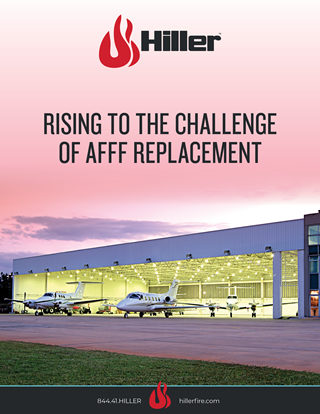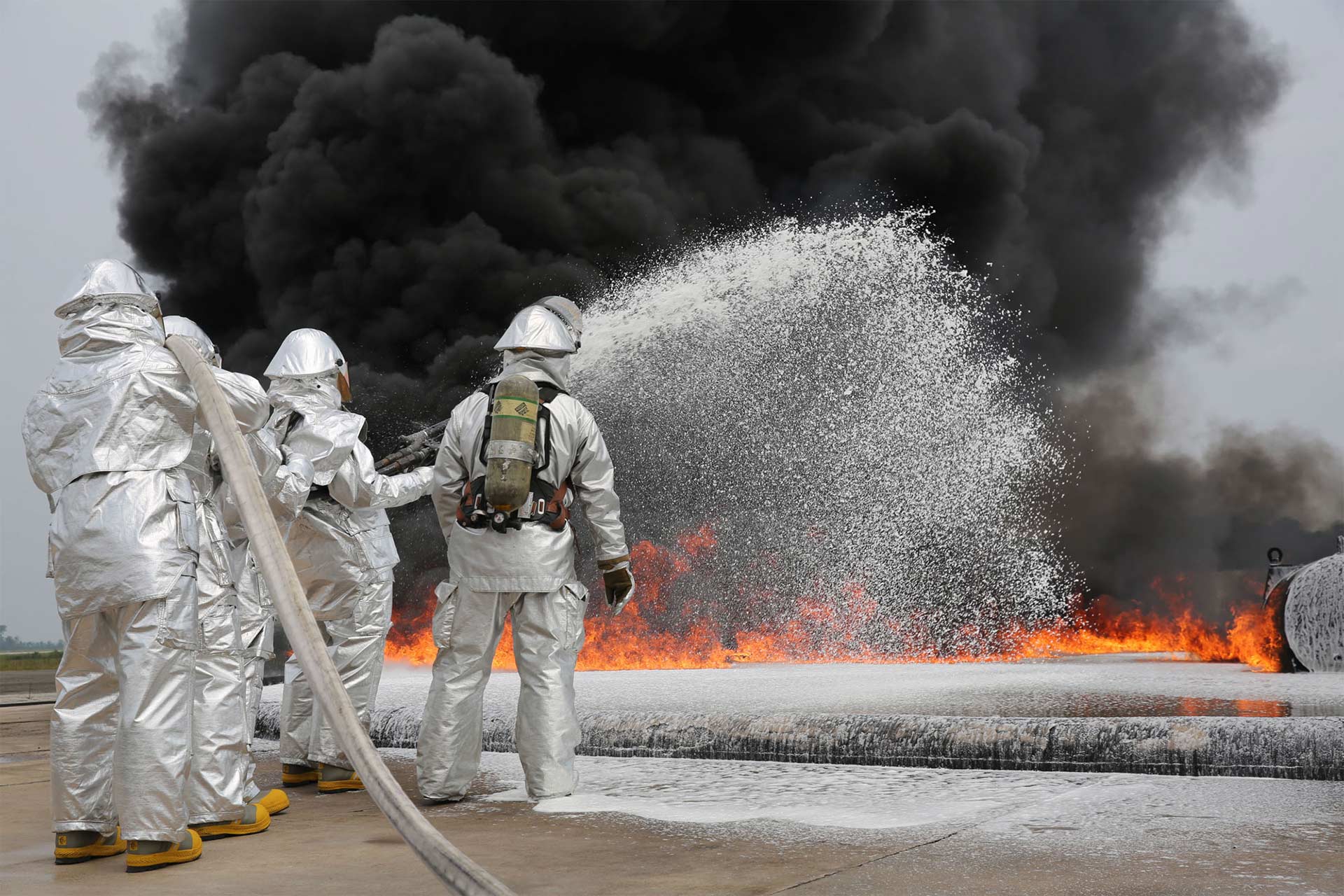Hiller is actively researching and investing in effective replacement of the current AFFF firefighting foams, which contain environmentally undesirable man-made fluorinated chemicals generally known as PFAS. The goal is to replace these foam concentrates with a fluorine-free alternative that maintains the same firefighting effectiveness with no or little change to the supply volume and the existing delivery systems. This is a major task for the U.S. Government, military, and the commercial industry since AFFF foam has been widely used after its development by the U.S. Navy in the mid-1960s for mission critical extinguishment of petroleum-based fires. To learn more about AFFF and your application contact us.
The History of AFFF
The development of aqueous film-forming foam is over a century in the making. Firefighting foam was first invented in the early 1900s to suppress fires by cooling the fire and coating the fuel, preventing contact with oxygen and further combustion. For the next 50 years, variations of compounds would be researched and subsequent advancements were implemented in the firefighting foam sector. In the 1960s, the Naval Research Laboratory in partnership with the 3M Company began conducting research on the use of synthetic chemicals to create a more effective firefighting foam to suppress hydrocarbon fuel-based fires. The result of the research was a new foam solution called aqueous film-forming foam (AFFF), which was patented by the U.S. Navy in 1966.
AFFF is a combination of fluorocarbons, surfactants, and solubilizers. The fluorochemical based surfactant reduces the surface tension of water allowing the foam to form an aqueous film on the surface of the hydrocarbon fuel that:
(1) suppresses vapors
(2) deprives the fuel surface of oxygen, and
(3) prevents evaporation and subsequent re-ignition of the fuel.
Its low viscosity allows the synthetic foam to spread across the surface of flammable liquids rapidly and
prevents reignition once the fire has been put out. With a nearly instantaneous fire knockdown capability, AFFF became widely used by the Navy in crash rescue fighting and mission critical extinguishment of petroleum-based fires. By the late 1960s, the U.S. Navy required AFFF on all of its vessels. In the 1970s, the Department of Defense began using AFFF at all military installations.
What are PFAS?
The key synthetic surfactants that are utilized in AFFF are perfluoroalkyl and polyfluoroalkyl substances
(PFAS). Historically, perfluorooctane sulfonate (PFOS) and perfluorooctanoic acid (PFOA) are the most widely used PFAS in the U.S. PFAS are not uniquely attributable to military activities. They are found in an expanse of industrial and consumer products (such as non-stick cookware, stain-resistant fabrics and food packaging) because they increase resistance to heat, stains, water, and grease. A variety of other industries, including aerospace, automotive and electronics use PFAS as they help reduce friction.
PFAS Exposure and Effects
In recent years, the U.S. Environmental Protection Agency has found that PFAS do not break down and they can accumulate over time. Both PFOA and PFOS are persistent in both the environment and in the human body.
Sources of PFAS in the environment may include industrial sources, areas with frequent use of products containing PFAS (including airports and fire training areas), and consumer products. There are no natural sources of PFAS in the environment.
According to the Department of Defense, PFAS can be found in places such as:
- Public water systems and drinking water wells, soil, and outdoor air near industrial sources or areas with frequent PFAS use.
- Indoor air in spaces that contain carpets, textiles, and other consumer products treated with PFAS to resist stains.
- Consumer products including non-stick coatings on cookware, grease-resistant paper, and stain resistant coatings on carpets, upholstery, and other fabrics.
- Surface water (e.g., lakes, ponds) and runoff from areas where AFFF has been used, such as military or civilian airfields.
- Locally caught fish from water containing PFAS; and
- Food items sold in the marketplace.
- There is evidence that exposure can lead to adverse human health effects. Studies of laboratory animals indicate that PFOA and PFOS can cause reproductive and developmental, liver and kidney, and immunological effects as well as tumors. The most consistent findings among exposed populations are increased cholesterol levels, with more limited findings of:
- Low infant birth weights,
- Effects on the immune system,
- Cancer (for PFOA), and
- Thyroid hormone disruption (for PFOS).
PFAS Regulations
As a result of increased studies on the negative impacts of exposure, PFAS are the subject of increasing regulation worldwide. In 2006, the U.S. EPA launched the PFOA Stewardship Program, which resulted in the dramatic decline of PFAS manufacturing in the United States. Specifically, eight major chemical manufacturers agreed to eliminate the use of PFOA and PFOA-related chemicals in their products and as emissions from their facilities. However, the man-made chemicals are still produced internationally and can be imported in the U.S. in consumer goods.
In 2016, the U.S. EPA issued a lifetime Health Advisory for PFOS and PFOA in drinking water of 70 parts per trillion. This health advisory level offers a margin of protection for all Americans throughout their life from adverse health effects resulting from exposure to PFOA and PFOS in drinking water.
Specific to U.S. military operations, the National Defense Authorization Act (NDAA), issued in December 2019, calls for the removal of PFAS-containing foams in all military installations by October 1, 2024.
Department of Defense Usage of AFFF
Historically, Department of Defense (DoD) has used AFFF containing PFOS and PFOA in firefighting and crash response vehicle testing, fire training exercises, crash crew training exercises, hangar system operations and testing, responses to fuel fires or spills, and emergency response actions. DoD also uses materials that can contain PFAS in the vapor suppression systems at plating shops. Releases into the environment can result from use, spills and leaks of these materials during handling or in storage, wastewater treatment, and disposal locations. Although EPA’s Health Advisory is guidance and is not an enforceable drinking water standard, DoD has proactively addressed drinking water impacted by releases of PFAS that are attributable to DoD activities.
It follows the process as set forth by the Comprehensive Environmental Response, Compensation, and Liability Act of 1980 (CERCLA) to fully investigate releases, prioritize responses, and determine appropriate cleanup actions based on risk. Under CERCLA, DoD investigates if a release occurred, takes short-term cleanup actions (called “removal actions”) where there is an immediate need for action, and takes long-term cleanup actions (called “remedial actions”) to address any remaining unacceptable risks.
The process from the initial assessment to the beginning of actual cleanup is a multi-year effort.
Specific to firefighting foam, DoD updated the Military Specification (MILSPEC) for AFFF, so that new supplies available for emergency firefighting responses do not contain detectable levels of PFOS or PFOA. DoD also prohibits using AFFF for maintenance, testing, and training on DoD installations worldwide and is actively researching fluorine-free alternatives to AFFF to prevent further releases of PFOS and PFOA into the environment.
Currently, AFFF is used during emergency responses and each use is treated as a spill response to limit environmental effects.
There are currently about 200 airports operated by DoD, which mostly use AFFF. Some of those airports are operated jointly with commercial aviation. DoD is partnering with the Federal Aviation Administration to ensure these airports maintain the current level of protection for passengers, crews and equipment.
AFFF Replacement Challenges
Department of Defense holds strict standards for putting out mission critical fires quickly and effectively.
The standards ensure the safety of service members as well as preservation of equipment.
Firefighting foam concentrate manufacturers have been researching and testing new formulas to replace PFAS foams for years with the objective of finding:
- A formula that is an environmentally friendly biodegradable solution
- A formula that will perform as well in terms of its capability to cover the hazard cooling and extinguishing the fire and encapsulating the hazardous vapors
- A formula that will provide the coverage, extinguishment and maintain encapsulation as rapidly as the existing PFAS foams do
- A solution that would be a “drop-in” replacement for existing systems which would dramatically reduce the overall cost for upgrading existing fixed, mobile and portable systems
Related to PFAS and AFFF:
What is NFPA 11?
1.1* Scope.
1.1.1 This standard covers the design, installation, operation,
testing, and maintenance of low-, medium-, and high-expansion
and compressed air foam systems for fire protection.
1.1.2 It is not the intent of this standard to specify where foam protection is required.
1.2 Purpose.
1.2.1 This standard is intended for the use and guidance of those responsible for designing, installing, testing, inspecting, approving, listing, operating, or maintaining fixed, semifixed,
or portable low-, medium-, and high-expansion and com pressed air foam fire-extinguishing systems for interior or exterior hazards.
1.2.2 Nothing in this standard is intended to restrict new technologies or alternative arrangements, provided the level of safety prescribed by the standard is not lowered.
1.2.3 Low-, medium-, and high- expansion foam and compressed air foam systems are intended to provide property protection and not life safety.
For more information on NFPA 11 please visit NFPA website:
What is NFPA 409?
1.1 Scope.
1.1.1 This standard contains the minimum requirements for the proper construction of aircraft hangars and protection of aircraft hangars from fire.
1.1.2 This standard applies only to buildings or structures used for aircraft storage, maintenance, or related activities. Other uses within an aircraft hangar shall be protected in accordance with other applicable NFPA standards.
1.2* Purpose. The purpose of this standard is to provide a reasonable degree of protection from fire for life and property in aircraft hangars, based on sound engineering principles, test data, and field experience.
For more information on NFPA 409 please visit NFPA website.
What Color liquid is AFFF foam concentrate?
The color of AFFF can vary based on the manufacturer and type of AFFF. However, the color typically is pale yellow, light amber and include a reddish color.
Whatever the color of AFFF that you may be using, it is important to understand all the applications and benefits of using AFFF or finding an alternative for AFFF replacement, such as Synthetic Firefighting Foam.

_____________________________________________________________________________________
Reference Links:
https://www.fireproductsearch.com/best-practice-guidance-use-firefighting-foams/
Fact Sheets – PFAS — Per- and Polyfluoroalkyl Substances (itrcweb.org)
https://en.wikipedia.org/wiki/Firefighting_foam#History_ of_fire-fighting_foams
https://pfas-1.itrcweb.org/fact_sheets_page/PFAS_Fact_Sheet_AFFF_April2020.pdf
